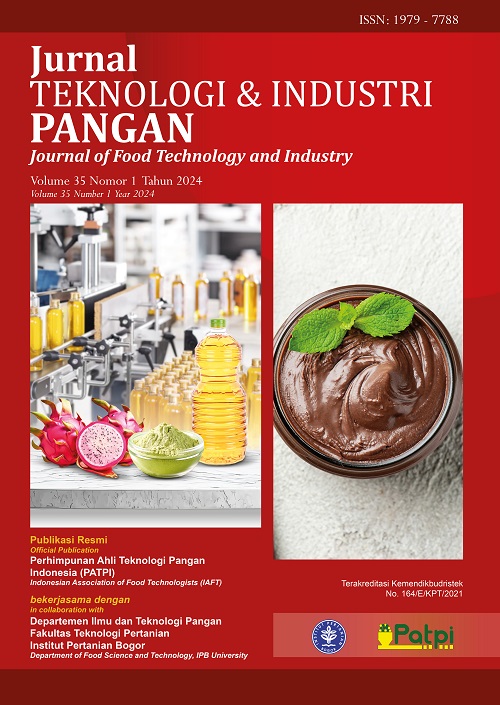Pencucian Crude Palm Oil (CPO) untuk Mitigasi Penurunan 3-MCPDE dan GE pada Pemurnian Minyak Sawit
Abstract
Crude palm oil (CPO) purification aims to remove or degrade unwanted components such as free fatty acids (FFA), phospholipids, impurities, color pigments, metals, and odors. The CPO purification generally consists of degumming, bleaching, and deodorization process. During the stages, some undesirable compounds are formed, including 3-monochloropropane-1,2-diol ester (3-MCPDE) and glycidyl ester (GE). The main precursors responsible for formation of the two compounds are chlorides and acyl glycerol fractions, especially diacylglycerol (DAG) and this occurs high temperatures in the deodorization process. Therefore, it is necessary to reduce their precursors in order to supress the contaminants. To cope with the problem, a washing process of CPO was proposed as an extra process before a purification stage. The washing process was carried out in two ways, namely wet washing by using water, and dry washing by using bleaching earth (BE) by 2 types of commercial BE (natural and acid activated). Washing processes using wet and dry washing (natural and activated BE) showed comparable effectiveness in reducing 3-MCPDE and GE levels in refined palm oil. As a result, the process successfully reduced 3-MCPDE content to comply with a standard Commission Regulation (EU) 2020/1332, but GE content did not conform to standard.
References
Almeida, D. T. D., Viana, T. V., Costa, M. M., Silva, C. D. S., & Feitosa, S. (2018). Effects of different storage conditions on the oxidative stability of crude and refined palm oil, olein and stearin (Elaeis guineensis). Food Science and Technology, 39, 211–217. https://doi.org/10.1590/fst.43317
Bariyah, K., Andarwulan, N., & Hariyadi, P. (2017). Pengurangan kadar digliserida dan asam lemak bebas dalam minyak sawit kasar menggunakan Adsorben. Agritech, 37(1), 49–59. https://doi.org/10.22146/agritech.17009
Cheng, W. W., Liu, G. Q., Wang, L. Q., & Liu, Z. S. (2017). Glycidyl fatty acid esters in refined edible oils: A review on formation, occurrence, analysis, and elimination methods. Comprehensive Reviews in Food Science and Food Safety, 16(2), 263–281. https://doi.org/10.1111/1541-4337.12251
Chew, S. C., & Nyam, K. L. (2020). Refining of edible oils. In lipids and edible oils. Academic Press, United States, 213–241. https://doi.org/10.1016/B978-0-12-817105-9.00006-9
[Commission Regulation (EU)]. (2020). Commission Regulation (EU) 2020/1322 Amending Regulation (EC) No 1881/2006 as regards maximum levels of 3‐monochloropr-opanediol (3-MCPD), 3-MCPD fatty acid esters and glycidyl fatty acid esters in certain foods.
Franke, K., Strijowski, U., Fleck, G., & Pudel, F. (2009). Influence of chemical refining process and oil type on bound 3-chloro-1, 2-propanediol contents in palm oil and rapeseed oil. LWT-Food Science and Technology, 42(10), 1751–1754. https://doi.org/10.1016/j.lwt.2009.05.021
Freudenstein, A., Weking, J., & Matthäus, B. (2013). Influence of precursors on the formation of 3‐MCPD and glycidyl esters in a model oil under simulated deodorization conditions. European Journal of Lipid Science and Technology, 115(3), 286–294. https://doi.org/10.1002/ejlt.201200226
Ghazani, S. M., & Marangoni, A. G. (2013). Minor components in canola oil and effects of refining on these constituents: A review. Journal of the American Oil Chemists' Society, 90, 923–932. https://doi.org/10.1007/s11746-013-2254-8
Huang, J., & Sathivel, S. (2010). Purifying salmon oil using adsorption, neutralization, and a combined neutralization and adsorption process. Journal of Food Engineering, 96(1), 51–58. https://doi.org/10.1016/j.jfoodeng.2009.06.042
Lakshmanan, S., & Yung, Y. L. (2021). Chloride reduction by water washing of crude palm oil to assist in 3-monochloropropane-1, 2 diol ester (3-MCPDE) mitigation. Food Additives & Contaminants: Part A, 38(3), 371–387. https://doi.org/10.1080/19440049.2020.1842516
Nga, J., Avom, J., Tonga Limbe, J., Ndinteh, D., Assonfack, H. L., & Kede, C. M. (2022). Kinetics and thermodynamics of β-carotene adsorption onto acid-activated clays modified by zero valent iron. Journal of Chemistry, 2022, 505556. https://doi.org/10.1155/2022/6505556
Silva, S. M., Sampaio, K. A., Ceriani, R., Verhe, R., Stevens, C., De Greyt, W., & Meirelles, A. J. (2014). Effect of type of bleaching earth on the final color of refined palm oil. LWT-Food Science and Technology, 59(2), 1258–1264. https://doi.org/10.1016/j.lwt.2014.05.028
Strijowski, U., Heinz, V., & Franke, K. (2011). Removal of 3‐MCPD esters and related substances after refining by adsorbent material. European Journal of Lipid Science and Technology, 113(3), 387–392. https://doi.org/10.1002/ejlt.201000323
Vispute, P., & Dabhade, S. (2018). Refining of palm oil: A review on palm oil refining process, 3-MCPD esters in refined palm oil, and possible reduction tactics for 3-MCPD esters. International Journal of Agricultural Engineering, 11, 81–85. https://doi.org/10.15740/HAS/IJAE/11.Sp.Issu/81-85
Weißhaar, R., & Perz, R. (2010). Fatty acid esters of glycidol in refined fats and oils. European Journal of Lipid Science and Technology, 112(2), 158–165. https://doi.org/10.1002/ejlt.200900137

